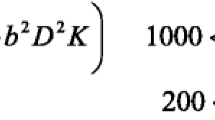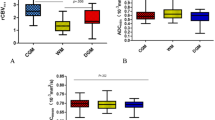Abstract
Purpose
This study was undertaken to correlate apparent diffusion coefficient (ADC) and relative regional cerebral blood volume (rrCBV) to histological findings in a large series of patients with primary or secondary brain tumours to evaluate diffusion-weighted (DWI) and perfusionweighted (PWI) imaging in the characterisation of cerebral tumors.
Materials and methods
Ninety-eight patients with cerebral tumours, 46 of which were primary (seven grade 0-I, nine low-grade gliomas, two gliomatosis cerebri, nine lymphomas and 19 high-grade gliomas) and 52 secondary, underwent conventional magnetic resonance (MR) imaging completed with DWI and dynamic contrast susceptibility PWI. Both ADC and rrCBV were calculated on a workstation by using Functool 2 software. Student’s t test was used to determine any statistically significant differences in the ADC and rrCBV values.
Results
Seventeen of 98 tumours were cystic or necrotic (12/17 hypointense and 5/17 hyperintense on DWI); the ADC value of hyperintense cystic areas was 0.97±0.23×10−3 mm2/s. The ADC value of solid tumours varied between 0.64 and 3.5×10−3 mm2/s. The rrCBV value was 1.4 (σ 0.66) in low-grade gliomas; 1.22 (σ 0.25) in lymphomas; 4.5 (σ 0.85) in grade III gliomas; 3.18 (σ 1.26) in grade IV gliomas and 2.53 (σ 1.6) in metastases.
Conclusions
DWI has an important role in the differential diagnosis of cystic cerebral masses but not in tumour characterisation. PWI is helpful in differentiating high-from low-grade gliomas and lymphomas from high-grade gliomas.
Riassunto
Obiettivo
Correlare i valori del coefficiente di diffusione apparente (ADC) e del volume cerebrale medio (rrCBV), ottenuti su un’ampia serie di pazienti con tumori cerebrali (primitivi o secondari), con il dato istologico per valutare l’apporto delle tecniche di diffusione (DWI) e perfusione (PWI) nella caratterizzazione dei tumori cerebrali.
Materiali e metodi
Novantotto pazienti con tumore cerebrale, 46 con tumore primitivo (7 di grado 0–I, 9 gliomi a basso grado, 2 gliomatosi cerebri, 9 linfomi, 19 gliomi ad alto grado) e 52 con metastasi sono stati sottoposti ad esame RM convenzionale completato da acquisizione DWI e da studio perfusionale ottenuto durante la somministrazione di un bolo di gadolinio. Su tutte le lesioni sono state effettuate rielaborazioni su una work-station per il calcolo dell’ADC e della rrCBV utilizzando il software “functool 2”. Sono state effettuate rielaborazioni statistiche utilizzando il test t di Student per dati non appaiati.
Risultati
Diciassette tumori erano costituiti da una componente centrale cistica che in 5 casi era iperintensa in DWI (valore medio ADC 0,97±0,23×10−3 mm2/s). L’ADC della parte solida dei tumori aveva valori compresi tra 0,64 e 3,5×10−3 mm2/s. L’rrCBV media è risultata di 1,4 (σ 0,66) nei gliomi a basso grado; 1,22 (σ 0,25) nei linfomi; 4,5 (σ 0,85) nei gliomi grado III; 3,18 (σ 1,26) nei gliomi grado IV e 2,53 (σ 1,6) nelle metastasi.
Conclusioni
Le acquisizioni DWI hanno un ruolo rilevante nella diagnosi delle masse cistiche, mentre non sembrano avere un ruolo nella caratterizzazione dei tumori. La PWI fornisce elementi utili nella diagnosi differenziale tra gliomi a basso ed alto grado e tra gliomi ad alto grado e linfomi.
Similar content being viewed by others
References/Bibliografia
Zonari P, Baraldi P, Crisi G (2007) Multimodal MRI in the characterization of glial neoplasm: the combined role of single-voxel MR spectroscopy, diffusion imaging and echo-planar perfusion imaging. Neuroradiology 49:795–803
Provenzale JM, Mukundan S, Barboriak DP (2006) Diffusionweighted and perfusion MR imaging for brain tumor charecterization and assessment of tratment response. Radiology 239:632–649
Bulakbsi N, Kocaoglu M, Farzaliyev A et al (2005) Assessment of diagnostic accuracy of perfusion MR imaging and metastastic solitary malignant brain tumors. AJNR Am J Neuroradiol 26:2187–2199
Hakyemez B, Erdogan C, Ercan I et al (2005) High-grade and low grade gliomas: differentiation by using perfusion MR imaging. Clin Radiol 60:493–502
Nadal Desbarats L, Herlidou S, De Marco G et al (2003) Differential MRI diagnosis between brain abscesses and necrotic or cystic brain tumors using tha apparent diffusion coefficient and normalized diffusion-weighted images. Magn Reson Imaging 21:645–650
Sorensen AG, Reimer P (2001) Imaging RM di perfusione cerebrale. Principi ed applicazioni correnti. CIC edizioni internazionali, Roma
Vonken EPA, Van Osch MJP, Willems PWA et al (2000) Repeated quantitative perfusion and contrast permeability measurement in the MRI examinations of a CNS tumor. Eur Radiol 10:1447–1451
Boxerman JL, Schmainda KM, Weisskoff RM (2006) Relative cerebral blood volume maps corrected for contrast agent extravasation significantly correlate with glioma tumor grade, whereas uncorrected maps do not. AJNR Am J Neuroradiol 27:859–867
Provenzale JM (2007) Imaging of angiogenesis: clinical techniques and novel imaging methods. AJR Am J Roentgenol 188:11–23
Kremer S, Grand S, Rémy C et al (2004) Contribution of dynamic contrast MR imaging to differentiation between dural metastasis and meningioma. Neuroradiology 46:642–648
Dean BL, Drayer BP, Bird CR et al (1990) Gliomas, classification with MR imaging. Radiology 174:411–415
Essing M, Schkies M, Wenz F et al (2003) Assessment of brain metastases with dynamic susceptibility-weighted contrast-enhanced MR imaging: initial results. Radiology 228:193–199
Rollin N, Guyoatat J, Steichenberger N et al (2006) Clinical relevance of diffusion and perfusion magnetic resonance imaging in assessing intraaxial brain tumors. Neuroradiology 48:150–159
Cha S, Knopp EA, Johnson G et al (2002) Intracranial mass lesions: dynamic contrast-enhanced susceptibility-weighted echo-planar perfusion MR. Radiology 223:11–29
Hakyemez B, Erdogan C, Bolca N et al (2006) Evaluation of different cerebral mass lesions by perfusion-weighted MR imaging. J Magn Reson Imaging 24:817–824
Kitis O, Altay H, Calli C et al (2005) Minimum apparent diffusion coefficients in the evaluation of brains tumors. Eur J Radiol 55:393–400
Bükte Y, Paksoy Y, Genç E, Uca AU (2005) Role of diffusion-weighted MR in differential diagnosis of intracranial cyst lesions. Clin Radiol 60:375–383
Park SH, Chang KH, Song IC et al (2000) Diffusion-weighted MRI in cystic or necrotic intracranial lesions. Neuroradiology 42:716–721
Greco-Crasto S, Soffietti R, Rudà R et al (2007) Diffusion-weighted magnetic resonance imaging and ADC maps in the diagnosis of intracranial cystic or necrotic lesions. A retrospective study on 49 patients. Neuroradiol J 20:666–675
Hartman M, Jansen O, Heiland S et al (2001) Restricted diffusion within ring enhancement is not pathognomonic for brain abscess. AJNR Am J Neuroradiol 22:1738–1742
Al-Okaili RN, Krejza J, Wang S et al (2006) Advanced MR imaging. Techniques in the diagnosis of intraaxial brain tumors in adults. RadioGraphics 26:S173–S189
Bastin ME, Carpenter TK, Armitage PA et al (2006) Effects of dexamethasone on cerebral perfusion and water diffusion in patients with high-grade glioma. AJNR Am J Neuroradiol 27:402–408
Forsting M, Weber J (2004) MR perfusion imaging: a tool for more than stroke. Eur Radiol 14(Suppl 5):M2–M7
Tombach B, Heindel W (2002) Value of 1.0-M gadolinium chelates: review of preclinical and clinical data on gadobutrol. Eur Radiol 12:1550–1556
Benner T, Reimer P, Erb G et al (2000) Cerebral MR perfusion imaging: first clinical application of a 1 M gadolinium chelate (Gadovist 1.0) in a double-blinded randomized dosefinding study. J Magn Reson Imaging 12:371–380
Hakyemez B, Yildirim N, Erdogan C et al (2006) Meningiomas with conventional MRI findings resembling intraaxial tumors: can perfusionweighted MRI be helpful in differentiation? Neuroradiology 48:695–702
Uematsu H, Maeda M (2006) Doubleecho perfusion-weighted MR imaging: basic concepts and application in brain tumors for the assessment of tumor blood volume and vascular permeability. Eur Radiol 16:180–186
Lev MH, Ozsunar Y, Henson JW et al (2004) Glial tumor grading and outcome prediction using dynamic spin-echo MR susceptibility mapping compared with conventional contrastenhanced MR: confounding effect of elevated rCBV of oligodendroglimoas. AJNR Am J Neuroradiol 25:214–221
Wong JC, Provenzale JM, Petrella JR (2000) Perfusion MR imaging of brain neoplasm. AJR Am J Roentgenol 174:1147–1175
Yang S, Wetzel S, Law M et al (2002) Dynamic contrast-enhanced MR imaging of gliomatosis cerebri. AJNR Am J Neuroradiol 23:350–355
Yu A, Li K, Li H (2006) Value of diagnosis and differential diagnosis of MRI and MR spectroscopy in gliomatosis cerebri. Eur J Radiol 59:216–221
Author information
Authors and Affiliations
Corresponding author
Rights and permissions
About this article
Cite this article
Rizzo, L., Crasto, S.G., Moruno, P.G. et al. Role of diffusion- and perfusion-weighted MR imaging for brain tumour characterisation. Radiol med 114, 645–659 (2009). https://doi.org/10.1007/s11547-009-0401-y
Received:
Accepted:
Published:
Issue Date:
DOI: https://doi.org/10.1007/s11547-009-0401-y




